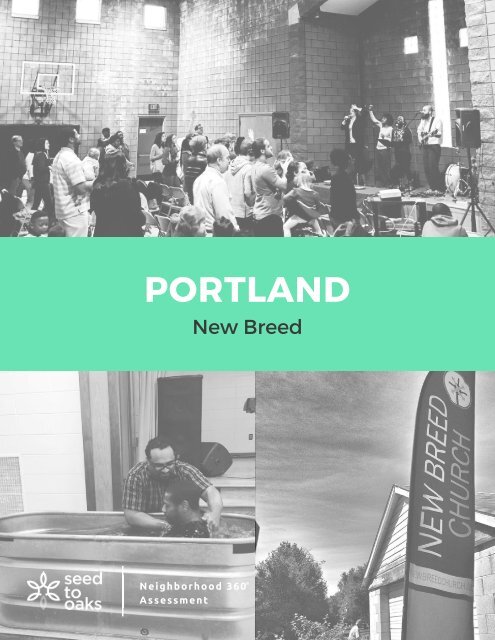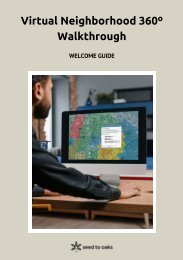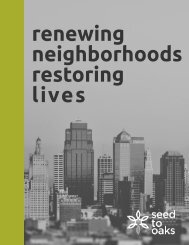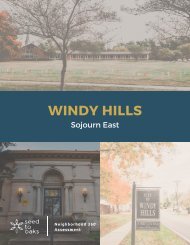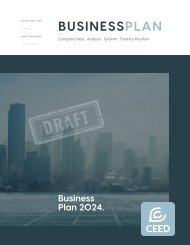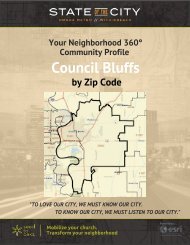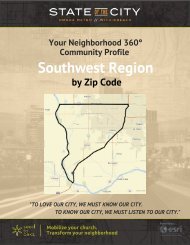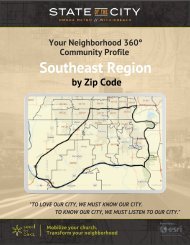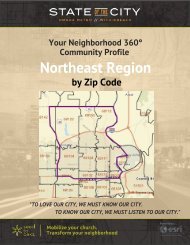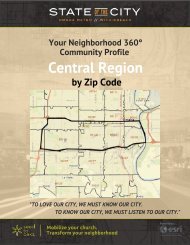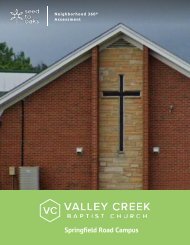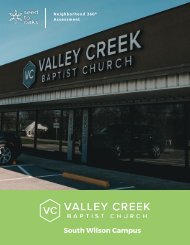New Breed Study
You also want an ePaper? Increase the reach of your titles
YUMPU automatically turns print PDFs into web optimized ePapers that Google loves.
PORTLAND<br />
<strong>New</strong> <strong>Breed</strong><br />
Neighborhood 360<br />
Assessment
WELCOME TO YOUR<br />
NEIGHBORHOOD 360 ASSESSMENT<br />
Introduction<br />
Neighborhood Snapshot<br />
History of Portland<br />
Demographics<br />
Local Insights<br />
Neighborhood Observations<br />
Assets of <strong>New</strong> <strong>Breed</strong><br />
Things to Keep in Mind While We Proceed<br />
Opportunities for Ministry<br />
Reflective Questions<br />
2<br />
3<br />
4<br />
5<br />
7<br />
9<br />
12<br />
13<br />
14<br />
15<br />
1
INTRODUCTION<br />
<strong>New</strong> <strong>Breed</strong> Church was planted in January of<br />
2014 by Pastor TC Taylor (formerly of Antioch<br />
Church) with Pastors Todd Robertson (Antioch)<br />
and Jamaal Williams (Sojourn Community<br />
Church) acting as external elders until <strong>New</strong><br />
<strong>Breed</strong> developed a process for raising up elders<br />
from it’s own congregation.<br />
Later that year, the predominantly black <strong>New</strong><br />
<strong>Breed</strong> expanded with the adoption of Portland<br />
Avenue Baptist Church, and her Pastors Michael<br />
and John Matala. As Portland Avenue Baptist<br />
was mostly white, <strong>New</strong> <strong>Breed</strong> became a<br />
vibrantly multi-ethnic church.<br />
Initially meeting in Shawnee High School, in<br />
2015 <strong>New</strong> <strong>Breed</strong> began meeting at Baptist<br />
Tabernacle Church which is between the<br />
Portland, Shawnee and Russell neighborhoods.<br />
One year later, for safety and environmental<br />
reasons, <strong>New</strong> <strong>Breed</strong> moved their worship<br />
gatherings to the Portland Promise Center, in<br />
the Portland neighborhood, where they still<br />
worship today.<br />
Despite these challenges in finding a<br />
permanent location to worship, <strong>New</strong> <strong>Breed</strong> has<br />
become a fellowship oriented congregation<br />
comprised of mostly young families who are<br />
determined to answer the Lord’s call to make<br />
disciples and to love neighbor as oneself.<br />
It may be tempting to interpret <strong>New</strong> <strong>Breed</strong>’s<br />
lack of a permanent building only through the<br />
lens of a trial. But consider this: God has<br />
intentionally given <strong>New</strong> <strong>Breed</strong> the opportunity<br />
to inhabit 1831 Baird Street, in Portland,<br />
Kentucky.<br />
The Lord has uniquely positioned <strong>New</strong> <strong>Breed</strong> to<br />
be a “city on a hill” in the Portland<br />
Neighborhood. How will we steward this<br />
opportunity and engage this community?<br />
To better understand Portland and the current<br />
barriers and bridges that exist, we<br />
commissioned a team of volunteers to conduct<br />
an in-depth neighborhood study of Portland.<br />
Our goal was to become students of Portland in<br />
order to become servants of the community. We<br />
surveyed neighbors door-to-door, conducted indepth<br />
interviews, spent hours walking and<br />
observing our streets, and collected<br />
demographic, historical and cultural data to<br />
complete this study.<br />
One of the the things that make a<br />
neighborhood study so valuable is the input<br />
that comes directly from the people who live in<br />
the community. Community studies reveal the<br />
specific dreams and felt needs of the<br />
community, and this in turn will enable <strong>New</strong><br />
<strong>Breed</strong> to more effectively share the love of<br />
Jesus in ways that are meaningful to those we<br />
want to touch. Rather than creating ministries<br />
that members of Portland might or might not<br />
find helpful, community studies allow us to<br />
lead by listening- and thus partner with people<br />
for the common good in the name of Jesus.<br />
At the end of this booklet, you will find a series<br />
of study questions and ideas. Our goal is to<br />
provide this study as a means of stimulating<br />
creative thinking. So, once you’ve read through<br />
this study, gather a few friends and discuss how<br />
your group or ministry can wisely and<br />
effectively engage the people of Portland.<br />
The <strong>New</strong> <strong>Breed</strong> Elders<br />
2
NEIGHBORHOOD SNAPSHOT<br />
<strong>New</strong> <strong>Breed</strong> Church is located within the<br />
Portland neighborhood, and meets at the<br />
Portland Promise Center at 1831 Baird<br />
Street.<br />
Ohio River<br />
64<br />
For the purposes of this study, the<br />
community of Portland is defined by the<br />
following street boundaries:<br />
Northwestern Pkwy/ I-64 on the north,<br />
Market Street on the south, 9th Street on<br />
the east, and I-264 on the west.<br />
The neighborhoods adjacent to Portland<br />
include: Shawnee to the west, Russell to<br />
the south, and Downtown Louisville to<br />
the east. The nearest community parks<br />
include Lannan Memorial park and<br />
Portland Wharf Park. Neighborhood<br />
geography spans 2.515 square miles.<br />
264<br />
N 122nd Street<br />
Baird Street<br />
Market Street<br />
9th Street<br />
3
HISTORY OF PORTLAND<br />
Communities are as different from one another as individuals are, and Portland is no<br />
exception. Founded in 1835, Portland drew French, Irish, and German immigrants. The<br />
advent of steamboats on the Mississippi occurred simultaneously with Portland's<br />
development, allowing the Ohio River to be used as a major freight shipping route in what<br />
was then the American Frontier. With a captive audience and a need for freight hauling,<br />
Portland's Wharf flourished as numerous taverns, warehouses, and shipyards were built. In<br />
1833, the Louisville and Portland Canal was built around the Falls of the Ohio, causing many<br />
of the warehouses and shipyards to close and shifting economic power on the Falls to nearby<br />
Louisville.<br />
Later annexed by Louisville in 1837, Portland continued to grow to be Louisville’s largest<br />
neighborhood with a population of over 12,000 people. Portland has historically been a<br />
working class community with residents working in nearby factories. In the aftermath of the<br />
1937 flood, all areas of Portland nearest to the river were completely destroyed. The effects<br />
of flood displaced thousands of people from the area.<br />
West Louisville, including Portland, began to change during the 1960’s when the civil rights<br />
movement effected change towards many neighborhoods, causing businesses and many<br />
white citizens to move to the suburbs. One significant event that took place in the 1960’s<br />
was a riot on Greenwood Ave because an African American business owner was beaten by<br />
police officers. The riot resulted in West Louisville losing most businesses and resources that<br />
made it so prominent.<br />
Fast forward to today, the neighborhood, whose residents are among the lowest income<br />
levels in Louisville, is experiencing a rebirth and a revitalization. Many young families are<br />
moving back and are attracted by the historic architecture and inexpensive starter homes in<br />
Portland. Also emerging is small businesses such as The Table Cafe, McQuixote Books and<br />
Coffee, and Cup of Joy Cafe.<br />
4
LOCATION<br />
2 miles from downtown Louisville<br />
South border: Market Street<br />
North border: Northwestern Pkwy/ I-64<br />
East border: 9th Street<br />
West border: I-264<br />
RACE<br />
White 7444 (70%)<br />
Black: 2885 (27.1%)<br />
Asian: 1 (0%)<br />
Hispanic: 92 (0.9%)<br />
Two or More Races: 190 (1.8%)<br />
Other: 26 (0.2%)<br />
DEMOGRAPHICS<br />
PEOPLE<br />
Congressional District: John Yarmuth (D)<br />
State Senate District: Gerald Neal (D)<br />
State House Districts: Attica Scott (D primary),<br />
Incumbent Darryl Owens<br />
Metro Council Rep: Barbara Sexton Smith (D)<br />
Portland Now Inc. (Neighborhood Association):<br />
Kerrie Clifford, President<br />
PUBLIC SCHOOLS<br />
Portland Elementary School<br />
Atkinson Elementary School<br />
Western Middle School<br />
Shawnee High School<br />
PRIVATE SCHOOLS<br />
Northside Christian Academy<br />
POPULATION HIGHLIGHTS<br />
Total Population: 12,752<br />
Total Houses: 3936<br />
EDUCATION<br />
Higher Degree: 698 (10.4%)<br />
High School: 3785 (56.5%)<br />
No High School: 2219 (33.1%)<br />
MEDIAN HOUSEHOLD INCOME<br />
All White: $26,000<br />
Non-Hispanic White: $26,000<br />
Black: $19,200<br />
All: $22, 100<br />
EMPLOYMENT<br />
Unemployed: 972 (12.4%)<br />
Not in the Labor Force: 3973 (49.4%)<br />
Assistance Program SNAP: 1649 (41.9%)<br />
MARITAL STATUS<br />
Never Married: 1935 males (48%), 1743 females (41%)<br />
Married: 1079 males (27%), 1070 females (25%)<br />
Separated/Divorced: 866 males (22%), 967 females (23%)<br />
Widowed: 112 males (3%), 420 females (10%)<br />
AGE<br />
65+: 939 (9.3%)<br />
40-64: 2958 (29.3%)<br />
22-39: 2742 (27.1%)<br />
18-21: 571 (5.6%)<br />
0-17: 2901 (28.7%)<br />
FAMILY HOUSEHOLD TYPE<br />
Percentage of family households with children under the age of 18.<br />
Married: 282 (26.8%)<br />
Single Moms: 603 (57.3%)<br />
Single Dads: 167 (15.9%)<br />
5
DEMOGRAPHICS<br />
Demographic Summary<br />
Portland is the only predominantly white neighborhood on Louisville's West Side and continues to struggle<br />
with many of the issues faced by under resourced communities.<br />
61 percent of Portlanders are unemployed or not in the labor force. Of those who are working, 38.7 earn<br />
$15,000 or less annually.<br />
41.9 percent receive government assistance in the form of SNAP benefits<br />
56.5 percent have earned only their high school diploma, whereas 33.1 percent didn’t complete high school.<br />
Only 10.4 percent have earned a higher degree.<br />
35.1 percent of households are headed by a single mother, more than double the percentage of the greater<br />
Louisville area<br />
6
LOCAL INSIGHTS<br />
During the neighborhood study, surveys and interviews were conducted with a number of<br />
locals in order to obtain personal accounts of what life in the Portland neighborhood is<br />
like. Some common concerns and desires emerged from those conversations.<br />
D R U G U S E & P R E V E N T I O N<br />
A common thread among those in we talked to in Portland is the desire to free the<br />
community from drug addiction. Several locals voiced concerns over the prevalence of<br />
drug use in the neighborhood and one resident revealed that many see the consumption<br />
of drugs as a road to success in some way. According to one resident, the heroin and<br />
opioid crisis is now killing more victims annually than homicides and car crashes<br />
combined. Any ministry or partnership that assists in the prevention or recovery of drug<br />
use will be thought well of in the community.<br />
C H I L D R E N , Y O U T H & P A R E N T I N G<br />
There is a deep awareness of the need to teach, train, and mentor neighborhood youth.<br />
After-school programing, spending time with neighborhood children, and one-on-one<br />
mentoring were mentioned as desired pathways of church service. Yet, also mentioned is<br />
the reality that earning the trust of neighborhood families will take time, effort, and a<br />
commitment to engage residents over the course of months and years. Other desired<br />
opportunities for service included classes and/or peer-to-peer mentoring around<br />
parenting skills and parent accountability.<br />
7
I T T E R & B E A U T I F I C A T I O N<br />
L<br />
Several people mentioned that litter is a big problem in the neighborhood. From<br />
abandoned cars and old mattresses on the porch, to unmowed lawns and rusted, bent<br />
fence posts, a common theme that emerged from interviews with residents is a lack of<br />
pride in the appearance and upkeep of people’s property and personal space. Though<br />
some responsibility lies with residents themselves, Portland has experienced illegal<br />
dumping from neighborhood outsiders with vacant lots and alleys being prime targets.<br />
Street cleanups are a way church members can establish a welcomed presence in the<br />
neighborhood.<br />
R E S T O R I N G P R O P E R T I E S & V A C A N T L O T S<br />
Since Portland was founded in the 1800’s, many of the buildings and properties are<br />
actually historical landmarks. Due to neglect and general urban decay, a number of<br />
buildings have been torn down and with those buildings goes a piece of history.<br />
Residents long for renewal, yet lack the resources or ownership to make a difference.<br />
C O M M U N I T Y E V E N T S &<br />
F E S T I V A L S<br />
There is a desire in Portland for activities<br />
that will bring people together to<br />
accurately reflect the sense of unity and<br />
commonality among the people. Many<br />
residents mentioned their love of<br />
attending neighborhood festivals,<br />
concerts, picnics and block parties.<br />
Creating additional events or making<br />
existing ones better was mentioned as a<br />
way to create the togetherness needed<br />
to combat the isolation felt by many.<br />
8
G E N T R I F I C A T I O N H O P E S A N D C O N C E R N S<br />
Gentrification is defined as the buying and renovating of houses and stores in<br />
deteriorated urban neighborhoods by middle or upper income families, individuals or<br />
businesses. While this improves property values it often displaces low-income families<br />
and small businesses. The 10-year Portland Investment Initiative is a $24 million<br />
revitalization effort for the neighborhood that started about four and a half years ago.<br />
Developers are beginning to restoring homes and commercial properties. Some<br />
residents are excited about the activity and investment. However, there are also<br />
concerns that residents will be unable to keep up with the increasing property values,<br />
taxes and rent that often result from such activity.<br />
C O M M U N I T Y A N D C O M M E R C E<br />
Regarding the community aspect of the<br />
neighborhood, we observed that many<br />
neighborhood residents are not involved at all,<br />
or at most only involved in one organization.<br />
We discovered that people tend to gather at<br />
the many Community centers throughout the<br />
neighborhood which include Love City, the<br />
Portland Promise Center, the Neighborhood<br />
House, the Molly Leonard Portland Community<br />
Center, the Community Catholic Center and the<br />
Porter House. Supporting any one of these<br />
centers may be an excellent way for church<br />
members to leverage their gifts and grow their<br />
influence.<br />
10
P O L I C E & G O V E R N M E N T P R E S E N C E<br />
The First Division LMPD station resides on 29th and Griffith Street. We learned that LMPD<br />
and security firms maintain a presence at a number of local businesses, such as the Portland<br />
Kroger where officers are present at the entrance. Some residents mentioned concerns of<br />
racial profiling and officers being disrespectful. Others, however, believe the police are<br />
doing the best they can with the resources they have. Councilwoman Jessica Green said in<br />
an article that she would like more residents to teach their children that police work is an<br />
honorable profession and that more black residents need to sign up for the police force.<br />
E C O N O M I C L I F E<br />
There are some businesses throughout the neighborhood, but in large part, if someone is<br />
going to find work that will pay a living wage, the individual will have to find it outside of<br />
the community. Most businesses in the community include corner stores, health clinics, a<br />
few fast restaurants, community centers, small auto repair shops, public schools and some<br />
small businesses sprinkled throughout the neighborhood. A job training or placement<br />
ministry would meet the need of individuals seeking job opportunities.<br />
C H U R C H E S & S P I R I T U A L L I F E<br />
Portland has historically been characterized an Irish-Catholic neighborhood, but much of<br />
that has disappeared. Prominent religious organizations in the neighborhood include Our<br />
Lady of Peace, Shawnee Baptist, Love City, Church of the Promise, along with a number of<br />
Baptist, Church of Christ and Pentecostal/Charismatic churches spread throughout.<br />
The spiritual climate of the neighborhood is fogged with a heavy amount of poverty,<br />
addiction and other vices. The spiritual climate though is helped by having so many<br />
different churches and ministries that are seeking to bring positive change to the<br />
community. Church collaboration however is something the body of Christ in Portland<br />
struggles with.<br />
11
ASSETS OF NEW BREED<br />
Overall, <strong>New</strong> <strong>Breed</strong> fits well into the surrounding community. <strong>New</strong> <strong>Breed</strong> is as multi-ethnic<br />
as the rest of Portland, though the socio-economic status of the average <strong>New</strong> <strong>Breed</strong> family is<br />
a bit higher. <strong>New</strong> <strong>Breed</strong> Church is located in the perfect neighborhood for a multiethnic<br />
church.<br />
Physical Assets - Use of the Portland Promise Center.<br />
Individual Assets - Young, multi ethnic congregation.<br />
Ministry Groups Assets - Community Groups<br />
12
We asked residents what are the characteristics of “good leaders”? The answers included<br />
“Someone willing to be an advocate,” “have a love/passion for the people and the<br />
community,” “be willing to stand for what’s right, ” “care about people,” and “have a heart for<br />
the neighborhood.” This means that as a church:<br />
THINGS TO KEEP IN MIND AS WE PROCEED<br />
We have to focus on what kind of difference we can make with one area.<br />
The amount of needs can be overwhelming; we don’t need to “fix” the community.<br />
It is up to us to not see people who need to be fixed, but instead, figure out how we can<br />
partner with the community to improve it.<br />
We are here to learn.<br />
We are here to contribute to see progress made in the community.<br />
We believe in collaborating with existing organizations while also finding a way we can<br />
help in a unique way.<br />
We are here to point others to the saving work of Jesus as we live lives of justice out of<br />
merciful love.<br />
13
The following are potential pathways for <strong>New</strong> <strong>Breed</strong> members, ministries and community<br />
groups to consider as a means of increasing their commitment to the Portland neighborhood.<br />
These recommendations, if adopted, could be a powerful way for <strong>New</strong> <strong>Breed</strong> to meet real<br />
needs as a means of advancing the Great Commission and making disciples of Jesus Christ.<br />
OPPORTUNITIES FOR MINISTRY<br />
1. Conduct and coordinate an asset map of individuals and families that highlight their<br />
gifts, capacities, and abilities.<br />
2. Peer-to-peer parent programs<br />
3. After school education support<br />
4. Job connectivity<br />
5. Beautification Efforts<br />
6. Non-profit partnerships and support<br />
7. <strong>New</strong> Community Events and Support of existing ones<br />
14
REFLECTIVE QUESTIONS<br />
1. What, if anything, changed in your understanding of the community around Portland?<br />
2. What new opportunities do you see for <strong>New</strong> <strong>Breed</strong> to love and connect with our<br />
community as a result of this study?<br />
3. How do you imagine this study will change or impact our church?<br />
4. How might your community group use the insights in this study to engage and connect<br />
with the community around you?<br />
15
Neighborhood 360<br />
Assessment


